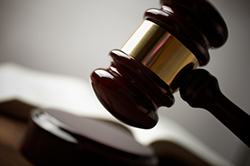 Vicarious simply means ‘in place of’. Vicarious liability is a legal term that refers to a kind of secondary accountability. In other words, Person A is responsible for the wrongdoings of Person B, even though Person A had no direct involvement in the offence.
Vicarious simply means ‘in place of’. Vicarious liability is a legal term that refers to a kind of secondary accountability. In other words, Person A is responsible for the wrongdoings of Person B, even though Person A had no direct involvement in the offence.
Vicarious liability is a doctrine (a belief or set of beliefs) of English tort law. In simple terms, a tort is a civil wrongdoing. It occurs when someone unjustly causes another person to suffer harm or loss. The person who commits the tortious act is the tortfeasor.
We can use a hypothetical situation in the workplace to illustrate how this works.
Hypothetical Case Study
Let’s say, for example, that Bob gets into a debate with Tom on the factory floor. Let’s also assume that things get a little heated and out of control, so much so that Tom does something fundamentally wrong and ends up injuring Bob. Because of the vicarious liability law, the employer can be liable for Tom’s injury on Bob. The argument could be that the company failed to supply a safe working environment for its more ‘stable’ employees. Or there could be any number of other conditions that might apply. In many situations this is a common sense ruling, but it also has its critics.
Such incidents don’t stop at employee conflicts within a company either. The same law can also apply to a customer on the premises who becomes the victim of an employee’s bad actions. How legitimate or successful a claim is will depend on a number of factors.
What It Means – in a Nutshell
If an employee causes physical or mental harm to another person (colleague or customer) in the course of his or her employment, the victim can take legal action. This legal action is against the employer, rather than the offender (employee).
Here are the four main points to consider with regard to vicarious liability cases:
1. Has a tort actually occurred?
2. Is the individual who carried out the tort an employee of the company?
3. Who is the ‘direct’ employer?
4. Is there enough association to link the tort and the employment?
Let’s break down each of these points in brief.
1. Has a Tort Occurred?
As obvious as it sounds, there cannot be any liability without a definite tort. It’s the first question to ask in such cases. Understand the difference between a civil wrongdoing and something that’s just upsetting or unpleasant.
2. Is the Tortfeasor an Employee of the Company?
This can be trickier than it sounds. The tortfeasor might be working at the company as a contractor or for a contractor at that location. An employee, in its true definition, is someone who is in direct and continual employment by the company. It’s an important definition to make when preparing a case.
3. Who Is the Direct Employer?
This is yet another potentially tricky issue. It’s a simple question, but it’s important to know the exact answer. For example, you might hire a limousine with a driver to pick up visitors from the airport. Your question is this: who employs the driver of the vehicle? Even though you have hired the car and the driver, who actually has direct control over the driver during this time? Is it your company or the company he came from?
4. Enough Association to Link the Tort to the Employment
They call this the ‘close connection test’, and it’s important. How closely connected was the tortfeasor’s act to his employment? It might be the case that the act had no relationship to the employment other than it happened on company time and on company premises. Or it may be because the wrongdoer did a bad job or gave hostile service, thus committing a work-related tort. How these things pan out is contingent on individual circumstances.
Note that there should be a satisfactorily close link between an employee’s misconduct and his or her employment. Then, and only then, is it proper to hold the employer accountable for the employee’s actions.
The Supreme Court Ruling
In March 2016, The Supreme Court ruled that the law can indeed hold employers accountable for crimes committed by staff at their place of work. This ruling came about as a result of a case involving a Morrison’s customer. The individual in question was the victim of a vicious, racist assault by a Morrison’s employee in 2008. In this case there was a satisfactorily close connection between the employee’s misconduct and their employment. That last point is the foundation for all vicarious liability claims.
Despite the ruling by the British Supreme Court, many employers are still unaware of the vicarious liability law. This law can come into play for all manner of offences committed by employees. These might include physical violence, bullying and harassment (physical or verbal). Discriminatory actions, libel and a breach of copyright may also apply.
The law of tort can be studied through our Legal Secretaries Diploma course here at The Institute of Legal Secretaries and PAs. Whichever way you choose to investigate this subject further, you are likely to find the law of tort to be a truly fascinating branch of our legal system.

